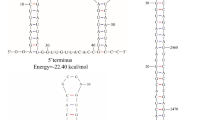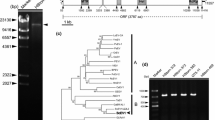Abstract
Here, a novel mycovirus, Botryosphaeria dothidea narnavirus 5 (BdNV5), was discovered in the plant-pathogenic fungus Botryosphaeria dothidea strain ZM210167-1. The BdNV5 genome sequence is 2,397 nucleotides (nt) in length and contains a putative open reading frame (ORF) encoding an RNA-dependent RNA polymerase (RdRp) with a molecular mass of 72.77 kDa. A BLASTp search using the RdRp amino acid (aa) sequence showed that it was most similar to the RdRp of Botryosphaeria dothidea narnavirus 4 (42.35%). In a phylogenetic tree based on RdRp aa sequences, BdNV5 clustered with members of the family Narnaviridae. BdNV5 is thus a novel member of the family Narnaviridae infecting the phytopathogenic fungus B. dothidea.


Similar content being viewed by others
References
Ghabrial SA, Castón JR, Jiang DH, Nibert ML, Suzuki N (2015) 50-plus years of fungal viruses. Virology 479–480:356–368. https://doi.org/10.1016/j.virol.2015.02.034
Ghabrial SA, Suzuki N (2009) Viruses of plant pathogenic fungi. Annu Rev Phytopathol 47:353–384. https://doi.org/10.1146/annurev-phyto-080508-081932
Anders S, Pyl PT, Huber W (2015) HTSeq–a Python framework to work with high-throughput sequencing data. Bioinformatics 31(2):166–169. https://doi.org/10.1093/bioinformatics/btu638
Wang J, Ni YX, Liu XT, Zhao H, Xiao YN, Xiao XQ, Li SJ, Liu HY (2020) Divergent RNA viruses in Macrophomina phaseolina exhibit potential as virocontrol agents. Virus Evol 7(1):veaa095. https://doi.org/10.1093/ve/veaa095
Wang QQ, Cheng SF, Xiao XQ, Cheng JS, Fu YP, Chen T, Jiang DH, Xie JT (2019) Discovery of two mycoviruses by high-throughput sequencing and assembly of mycovirus-derived small silencing RNAs from a hypovirulent strain of Sclerotinia sclerotiorum. Front Microbiol 10:1415. https://doi.org/10.3389/fmicb.2019.01415
Reyes BMD, Fonseca PLC, Heming NM, Conceição LBA, Nascimento KTS, Gramacho KP, Arevalo-Gardini E, Pirovani CP, Aguiar ERGR (2023) Characterization of the microbiota dynamics associated with Moniliophthora roreri, causal agent of cocoa frosty pod rot disease, reveals new viral species. Front Microbiol 13:1053562. https://doi.org/10.3389/fmicb.2022.1053562
Chiapello M, Rodríguez-Romero J, Ayllón MA, Turina M (2020) Analysis of the virome associated to grapevine downy mildew lesions reveals new mycovirus lineages. Virus Evol 6(2):veaa058. https://doi.org/10.1371/10.1093/ve/veaa058
Yu X, Li B, Fu YP, Jiang DH, Ghabrial SA, Li GQ, Peng YL, Xie JT, Cheng JC, Huang JB, Yi XH (2010) A geminivirus-related DNA mycovirus that confers hypovirulence to a plant pathogenic fungus. Proc Natl Acad Sci U S A 107(18):8387–8392. https://doi.org/10.1073/pnas.0913535107
Kotta-Loizou I (2021) Mycoviruses and their role in fungal pathogenesis. Curr Opin Microbiol 63:10–18. https://doi.org/10.1016/j.mib.2021.05.007
Kotta-Loizou I, Coutts RH (2017) Studies on the virome of the entomopathogenic fungus Beauveria bassiana reveal novel dsRNA elements and mild hypervirulence. PLoS Pathog 13(1):e1006183. https://doi.org/10.1371/journal.ppat.1006183
Choi GH, Nuss DL (1992) Hypovirulence of chestnut blight fungus conferred by an infectious viral cDNA. Science 257(5071):800–803. https://doi.org/10.1126/science.1496400
Zhou LL, Li XP, Kotta-Loizou I, Dong KL, Li SF, Ni DJ, Hong N, Wang GP, Xu WX (2021) A mycovirus modulates the endophytic and pathogenic traits of a plant associated fungus. ISME J 15(7):1893–1906. https://doi.org/10.1126/10.1038/s41396-021-00892-3
Zhang HX, Xie JT, Fu YP, Cheng JS, Qu Z, Zhao ZZ, Cheng SF, Chen T, Li B, Wang QQ, Liu XQ, Tian BN, Collinge DB, Jiang DH (2020) A 2-kb mycovirus converts a pathogenic fungus into a beneficial edophyte for Brassica protection and yield enhancement. Mol Plant 13(10):1420–1433. https://doi.org/10.1371/10.1016/j.molp.2020.08.016
Kondo H, Botella L, Suzuki N, Mycovirus (2022) Diversity and evolution revealed/inferred from recent studies. Annu Rev Phytopathol 60:307–336. https://doi.org/10.1146/annurev-phyto-021621-122122
Retallack H, Popova KD, Laurie MT, Sunshine S, DeRisi JL (2021) Persistence of ambigrammatic narnaviruses requires translation of the reverse open reading frame. J Virol 95(13):e0010921. https://doi.org/10.1128/JVI.00109-2
Dinan AM, Lukhovitskaya NI, Olendraite I, Firth AE (2020) A case for a negative-strand coding sequence in a group of positive-sense RNA viruses. Virus Evo 6(1):veaa007. https://doi.org/10.1093/ve/veaa00
Zhang YH, Liang XF, Zhao MX, Qi T, Guo HL, Zhao J, Zhao J, Zhan GM, Kang ZS, Zheng L (2022) A novel ambigrammatic mycovirus, PsV5, works hand in glove with wheat stripe rust fungus to facilitate infection. Plant Commun 4(3):100505. https://doi.org/10.1016/j.xplc.2022.100505
Crous PW, Slippers B, Groenewald JZ, Wingfield MJ (2017) Botryosphaeriaceae: systematics, pathology, and genetics. Fungal Biol 121(4):305–306. https://doi.org/10.1016/j.funbio.2017.01.003
Marsberg A, Kemler M, Jami F, Nagel JH, Postma-Smidt A, Naidoo S, Wingfield MJ, Crous PW, Spatafora JW, Hesse CN, Robbertse B, Slippers B (2016) Botryosphaeria dothidea: a latent pathogen of global importance to woody plant health. Mol Plant Pathol 18(4):477–488. https://doi.org/10.1111/mpp.12495
Tang W, Ding Z, Zhou ZQ, Wang YZ, Guo LY Phylogenetic and pathogenic analyses show that the causal agent of apple ring rot in China is Botryosphaeria dothidea. Plant Dis 96(4):486–496. https://doi.org/10.1094/PDIS-08-11-0635
Zhao X, Zhang GL, Li BH, Xu XM, Dong XL, Wang CX, Li GF (2016) Seasonal dynamics of Botryosphaeria dothidea infections and symptom development on apple fruits and shoots in China. Eur J Plant Pathol 146:507–518. https://doi.org/10.1007/s10658-016-0935-5
Wang LP, Jiang JJ, Wang YF, Hong N, Zhang FP, Xu WX, Wang GP (2014) Hypovirulence of the phytopathogenic fungus Botryosphaeria dothidea: association with a coinfecting chrysovirus and a partitivirus. J Virol 88(13):7517–7527. https://doi.org/10.1128/JVI.00538-14
Zhai LF, Xiang J, Zhang MX, Fu M, Yang ZK, Hong N, Wang GP (2016) Characterization of a novel double-stranded RNA mycovirus conferring hypovirulence from the phytopathogenic fungus Botryosphaeria dothidea. Virology 493:75–85. https://doi.org/10.1016/j.virol.2016.03.012
Yang MM, Xu WX, Zhou XQ, Yang ZK, Wang YX, Xiao F, Guo YS, Hong N, Wang GP (2021) Discovery and characterization of a novel bipartite botrexvirus from the phytopathogenic fungus Botryosphaeria dothidea. Front Microbiol 12:696125. https://doi.org/10.3389/fmicb.2021.696125
Zhai LF, Yang MM, Zhang MX, Hong N, Wang GP (2019) Characterization of a botybirnavirus conferring hypovirulence in the phytopathogenic fungus Botryosphaeria dothidea. Viruses 11(3):266. https://doi.org/10.3389/10.3390/v11030266
Yang F, Hong N, Wang GP Mycovirus dsRNA extraction kit and its application: ZL201310072994.3. 2015-06-03
Song XZ, Cao JY, Xie SP, Wang YF, Yin XM, Guo YS, Xu C, Guo LH, Wu HY, Zhang M (2023) Molecular characterization of a novel ourmia-like virus from the phytopathogenic fungus Botryosphaeria dothidea. Arch Virol 168(4):106. https://doi.org/10.1007/s00705-023-05739-0
Zhai LF, Hong N, Zhang MX, Wang GP (2014) Complete dsRNA sequence of a novel victorivirus isolated from the pear stem wart fungus Botryosphaeria dothidea. Arch Virol 160(2):613–616. https://doi.org/10.1007/s00705-014-2285-y
Hillman BI, Esteban R (2012) Family Narnaviridae. In: King AMQ, Adams MJ, Carstens EB, Lefkowitz EJ (eds) Virus taxonomy-ninth report of the international committee on taxonomy of viruses. Elsevier Academic Press, Cambridge, MA, pp 1055–1060
Lin Y, Zhou J, Zhou X, Shuai SM, Zhou RD, An HL, Fang SG, Zhang SB, Deng QC (2020) A novel narnavirus from the plant-pathogenic fungus Magnaporthe oryzae. Arch Virol 165(5):1235–1240. https://doi.org/10.1007/s00705-020-04586-7
Zhang YH, Zhao J, Liang XF, Zheng L, Kang ZS (2020) A novel narnavirus isolated from the wheat stripe rust fungus Puccinia striiformis f. sp. tritici. Arch Virol 165(4):1011–1014. https://doi.org/10.1007/s00705-020-04545-2
Funding
This study was financially supported by the Open Fund of the State Key Laboratory for Biology of Plant Diseases and Insect Pests (SKLOF202103) and the Innovation and Entrepreneurship Training Program for College Students in Henan Province (202210466072).
Author information
Authors and Affiliations
Corresponding authors
Ethics declarations
Ethical approval
This article does not contain any studies with human participants or animals performed by any of the authors.
Conflict of interest
The authors declare that they have no conflict of interest.
Additional information
Communicated by Robert H.A. Coutts
Publisher’s Note
Springer Nature remains neutral with regard to jurisdictional claims in published maps and institutional affiliations.
Electronic Supplementary Material
Below is the link to the electronic supplementary material
Rights and permissions
Springer Nature or its licensor (e.g. a society or other partner) holds exclusive rights to this article under a publishing agreement with the author(s) or other rightsholder(s); author self-archiving of the accepted manuscript version of this article is solely governed by the terms of such publishing agreement and applicable law.
About this article
Cite this article
Song, X., Zhang, J., Ma, Q. et al. Molecular characterization of a novel narnavirus infecting the phytopathogenic fungus Botryosphaeria dothidea. Arch Virol 169, 38 (2024). https://doi.org/10.1007/s00705-024-05964-1
Received:
Accepted:
Published:
DOI: https://doi.org/10.1007/s00705-024-05964-1




